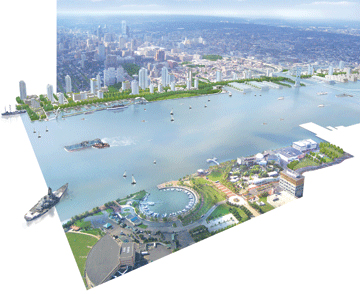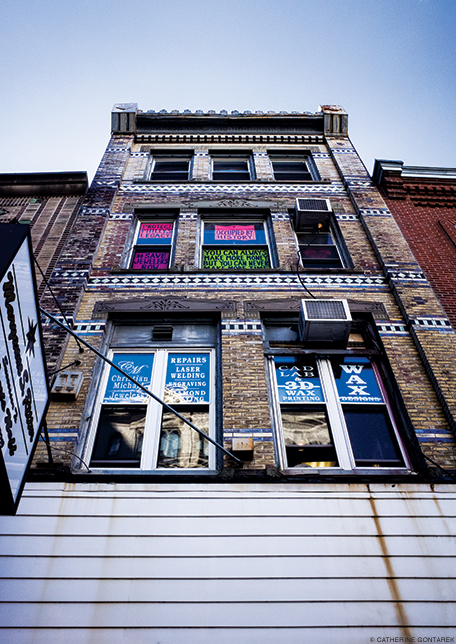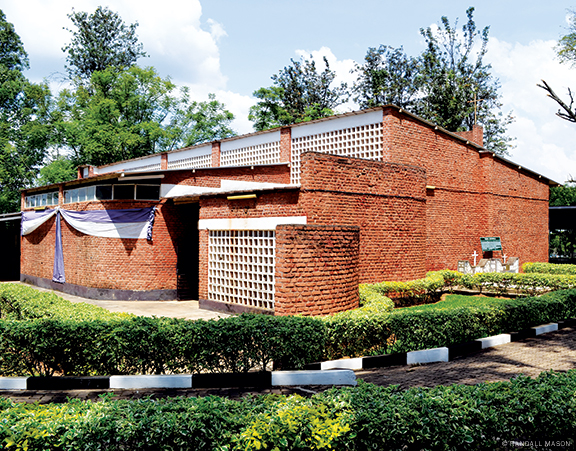
Inside the Pennsylvania Convention Center, a vision was unfolding. Some 1,500 people were packed into the large ground-floor meeting room and overflow room. The words A Civic Vision for the Central Delawareappeared on two large screens, soon replaced by a video chronicling the evolution of that vision and a Powerpoint presentation that walked the audience through the riverfront’s complex past, disappointing present, and hopeful future. A current of anticipation pulsed through the audience—as did a roiling undercurrent that booed its way to the surface every time somebody uttered certain loaded words, like casinos.
The evening’s emcee was Harris Steinberg C’78 GAr’82, director of Penn Praxis, the School of Design’s planning practice clinic, which has been shepherding the massive work-in-progress that is the Delaware waterfront plan [“Gazetteer,” Jan|Feb 2007]. Over the past year, the plan went from an unexpected authorization by Mayor John Street to a detailed civic vision, one that can be viewed in all of its 242-page glory at www.planphilly.com/vision. Along the way it has gathered serious momentum in a city not accustomed to transparent, publicly engaged decision-making. And despite some stormy public meetings and angry confrontations along the way—not to mention the looming specter of casinos and strong resistance from influential developers—the momentum hasn’t stopped.
It took “trial, tribulation, and—ultimately—triumph to get us where we are today,” Steinberg told the Convention Center audience. “This is our moment, and it is our moment to seize.”
Even Street, who had approved the state’s decision to locate two casinos on the waterfront, waxed enthusiastic.
“Every now and then we have an opportunity to make a difference,” the outgoing mayor told the audience. “This plan won’t languish—you aren’t going to let that happen, are you?”
“No!” chorused the audience.
“I know I’m preaching to the converted,” Street added puckishly, “but the converted are going to make this happen.”
The report is the result of a highly compressed year’s efforts to distill the sentiments from public meetings, forums, and river-walking sessions into a series of principles and values that informed the specific recommendations. The essence of the vision involves an “extension of Philadelphia to the river’s edge”—which, given the dysfunctional hodgepodge of blight and scattershot development on the waterfront now, is a lot more complicated than it sounds. It’s based on a set of “three interlocking networks that establish a framework for growth”: parks and open space; “movement systems” (streets, transits, and trails); and land development that can accommodate a broad mix of uses.
The key recommendations are relatively simple and practical rather than splashy. They include:
- Ensure public access to the riverfront through zoning, conservation easements, and acquisition of public spaces. Create a continuous riverfront trail with parks every 2,000 feet, including a large “lawn” at Penn’s Landing.
- Connect the city to the river’s edge by extending the street grid of the city—the one established by William Penn in 1683—to the riverfront. That grid, which will include a “new boulevard with mass transportation that is part of a comprehensive, regional network,” could accommodate a broad mix of townhouses, towers, retail businesses, and light industry.
- Start addressing the serious problem of I-95, which has severed the city from the waterfront for the past four decades and will be rebuilt over the next 35 years.
- Improve the quality of development by creating an “interim zoning overlay” and long-term zoning.
- Build on economic assets by “making use of innovative strategies for financing public infrastructure, city/state/federal collaborations, and partnerships with anchor institutions, such as the working port.”
- Get the ball rolling with “early-action projects” such as bike trails, improving Penn Treaty Park and Pulaski Park, and constructing tidal wetlands.
To achieve those goals, Philadelphia “will need to use tools it has not often used over the past 30 years, as it has largely handed over the role of public planning to the private development sector,” the report notes, adding that “it is the city’s responsibility to determine its own form and to regulate how buildings act along its streets.”
Contrary to Steinberg’s early assumption, the vision featured no “big signature pieces or theatrics” such as a call to immediately cover up I-95.
“The subtlety and elegance of the plan is its strength,” he says, “and it’s always been Philadelphia’s strength.” The template for extending the grid to the river has already proven its flexibility, having accommodated everything from Elfreth’s Alley to the towering new Comcast Center.
“What surprises me—but in retrospect is not surprising at all—is just the simplicity of the plan, that it is a simple and elegant extension of William Penn’s grid, in a 21st-century manner,” Steinberg says. “And that the flexibility of that grid—the interrelationship between public space, movement, and development—is as sound a planning tool today as it was 325 years ago.”
Councilman Frank DiCicco—who first raised the possibility of bringing in Penn Praxis—called the plan the “highlight of my political career.” It also prompted a lot of enthusiastic comments from the Fourth Estate, which, in the case of The Philadelphia Inquirer and Daily News, actively supported the process.
“The Penn Praxis plan represents Philadelphia’s last best hope for a walkable, democratic waterfront,” wroteInquirer architecture critic Inga Saffron the day after the presentation. After likening the plan to a smorgasbord of tempting options for incoming Mayor Michael Nutter W’79 to choose from, she added: “The only option Nutter shouldn’t consider is not partaking at all.”

Actually, there were two plans developed by Penn Praxis, which worked with the Philadelphia City Planning Commission and planning consultant Wallace Roberts and Todd as well as the 88-member Central Delaware Advisory Group. One includes the two casinos that Pennsylvania Governor Ed Rendell C’65 Hon’00 wants to locate on the waterfront, and which were sited there after Street authorized the civic vision. (“The controversial process that brought casinos to the Delaware did not allow for a thorough discussion of design and planning,” the plan notes.) The other, which was shown at the presentation, completely omits casinos. That “great compromise,” forged last May, helped calm the strong anti-casino sentiment (represented at the Convention Center by two large skunks handing out pamphlets at the door) and keep the process on track.
“Casinos dominated this process from the start,” Steinberg acknowledges. “In many ways, they gave it its reason to be. If casinos hadn’t been coming, the political will might not have been there to actually address this.
“When we started the project, they hadn’t been sited yet,” he points out. “So at the beginning of the process, many of the civic associations saw us as the savior of the waterfront. And early on, as I began to stake a neutral claim about casinos—saying, ‘This is not about casinos; it’s about seven miles; it’s about coming up with a framework for growth’—they began to see us skeptically. At some points, even, we were the skunk.”
While the anti-casino sentiment has never abated, Steinberg notes, the fact that the audience at the Convention Center was “so respectful demonstrated that we had achieved what we’ve set out to do, which was to be an honest broker.”
“This was much more politically impacted than most of the other projects we’ve engaged in,” says Harris Sokoloff, director of the Penn Project for Civic Engagement, who was responsible for creating a process that would illuminate the citizens’ values and consolidate them into a form the design and planning experts could use.
“The complexity there,” he points out, “is the diversity of values and dreams in the range of neighborhoods along those seven miles.”
One of those values is Philadelphia’s deeply entrenched “pay to play” civic mentality, which has often taken the form of developers using their financial leverage to gain city approval for their projects. Since most of the waterfront’s 1,146 acres are privately owned, the desires and clout of developers cannot be taken lightly. Michael Sklaroff L’67, a zoning attorney with Ballard Spahr Andrews Ingersoll who has been representing several developers, has argued that the plan ignored the “economic realities” of building on the river and warned that the grid proposal would be a “disastrous showstopper.” (Sklaroff and Steinberg tangled during one Philadelphia City Planning Commission meeting in October.)
But during the panel discussion that followed Steinberg’s presentation at the Convention Center, one prominent waterfront developer, Bart Blatstein, told the audience: “Planning, which is by nature controversial, is not the enemy. The enemy is lack of planning.” He called the report a “great start” but also cautioned that the process needed to become a “collaboration that includes property owners.”
“We’re really recommending that we think about different ways of encouraging development, less through tax incentives and more through targeted investment and infrastructure,” says Steinberg. “So let’s build parks instead of giving property-tax abatements. Let’s build streets and boulevards that can support mass transit, and use that as a way to [provide incentives to] the private market. But it’s going to take time for that discussion to be had.
“I don’t even think these ideas are very radical,” he adds. “They’re pretty old-fashioned—but in Philadelphia, that’s radical.”
Another confrontation came when 300 longshoremen showed up at a civic-engagement session at a South Philadelphia high school this past February. (Steinberg unwisely referred to them as “drunken” during his Convention Center presentation, and spent the next 24 hours apologizing for his brain cramp.)
“They were concerned in large part that the port would become condominiums, that this would be the pleasure ground of the rich and famous, that the governor would wipe out the port,” Steinberg explains. “We heard them and realized that at the same time they were negotiating and working on the extension of the port to the south and trying to build up the political collaboration to make this happen.”
The high emotions at that and other sessions simply come with the territory, says Sokoloff. “Our goal is not to avoid those emotions,” he explains. “Our goal is to tap into those emotions and the values that underlie them. People get emotional when they think that what’s important to them is being attacked. So our goal is to talk about what’s important to them.”
“This was an honest work of civic engagement,” says Steinberg. “It was about talking to people, it was about engaging Philadelphians. It wasn’t about Penn imposing our will and our pinhead-smarts on the city. And that was critical.”
Given the casino issue and the other political landmines, there was a “lot of cynicism, which I think is built into Philadelphia’s DNA,” Steinberg adds. “There were deals being made right, left, and center while this was happening. We were a small group, determined to talk before we acted. We had to manage political tensions in an election year. We had to manage inter-generational neighborhood tensions that often had nothing to do with the process. We had to manage the state and the imposition of its will on casinos, and port-related uses, and food-distribution centers—lots of different interests colliding along a waterfront that folks felt was probably never going to be reclaimed with the casinos coming. So we had to work doubly hard to gain the trust of the public—which we did, finally.”
What will happen to the plan in the long run remains to be seen. The recommendations are divided into short-term, mid-term, and long-term initiatives, as well as the “early-action” measures—such as bike paths or tidal wetlands—that Steinberg hopes will be enacted quickly. In the meantime, funding from the William Penn Foundation has been extended for two more years. The 15 civic associations have voted to stay together as an alliance, and Penn Praxis will provide support to them. The incoming mayor has hinted that he supports a 1,500-foot buffer zone between casinos and neighborhoods, which could force a relocation, though early last month the state Supreme Court ruled that the city had no authority to interfere with the Pennsylvania Gaming Board’s selection of the riverfront site of the SugarHouse Casino at Frankford Avenue.
Meanwhile, Steinberg and Penn Praxis are in it for the long haul. “There’s no end to this,” he says. “I think what we need to do is take a week and a half off, get some rest, and really take the admonition that many have given us: that this is a marathon and not a sprint.”
—S.H.




